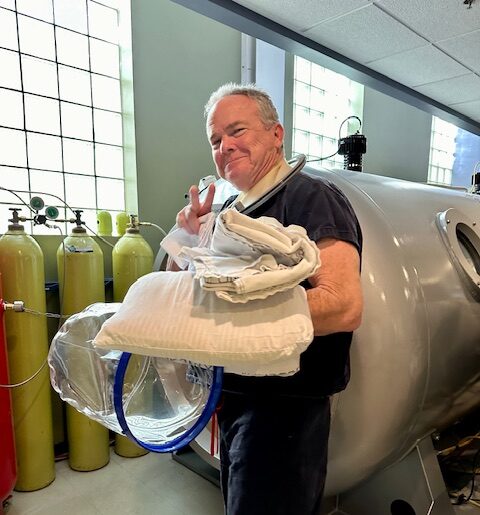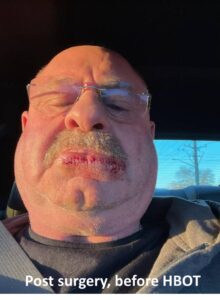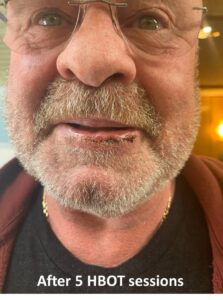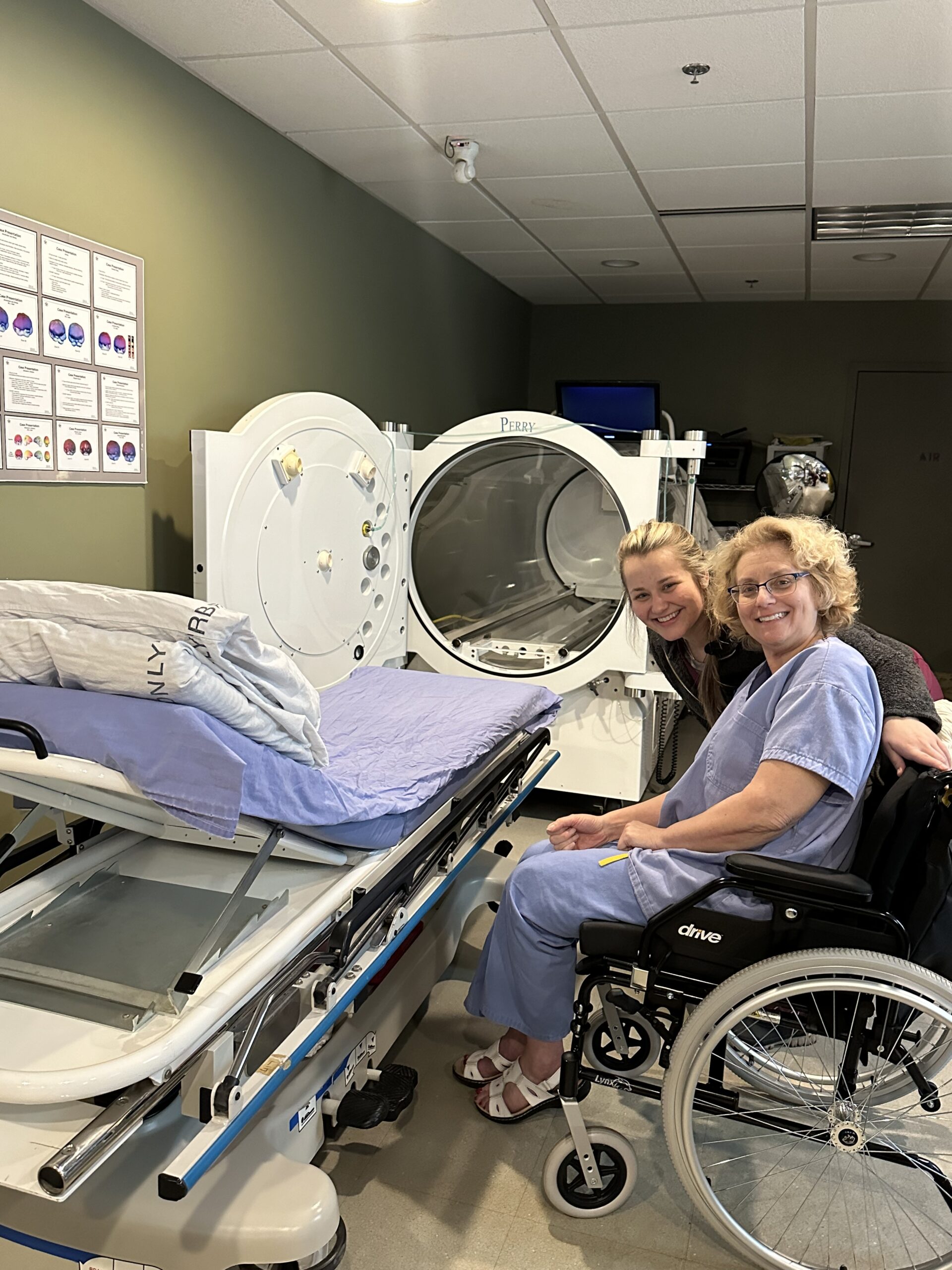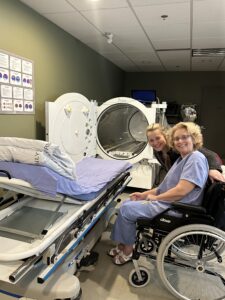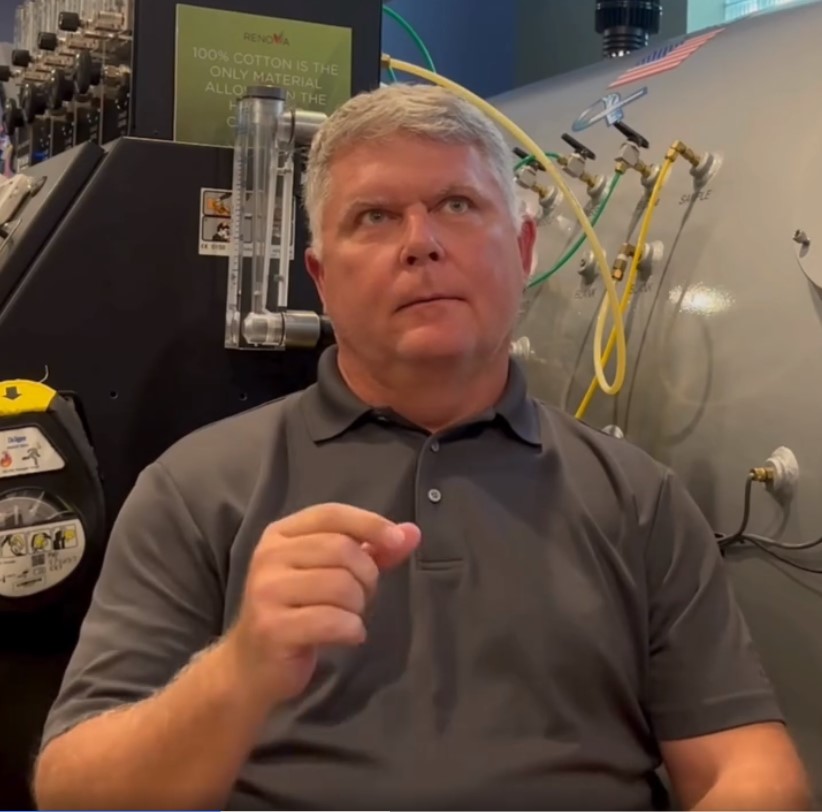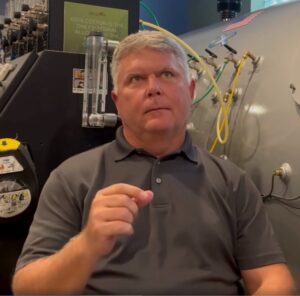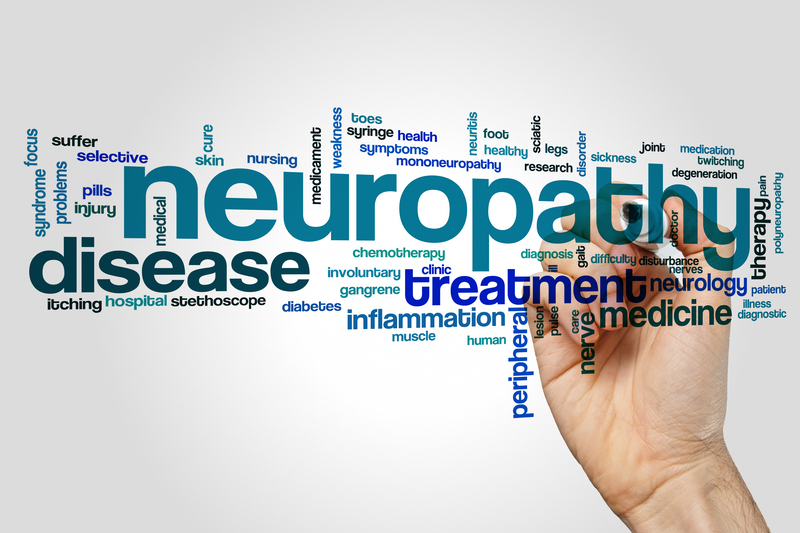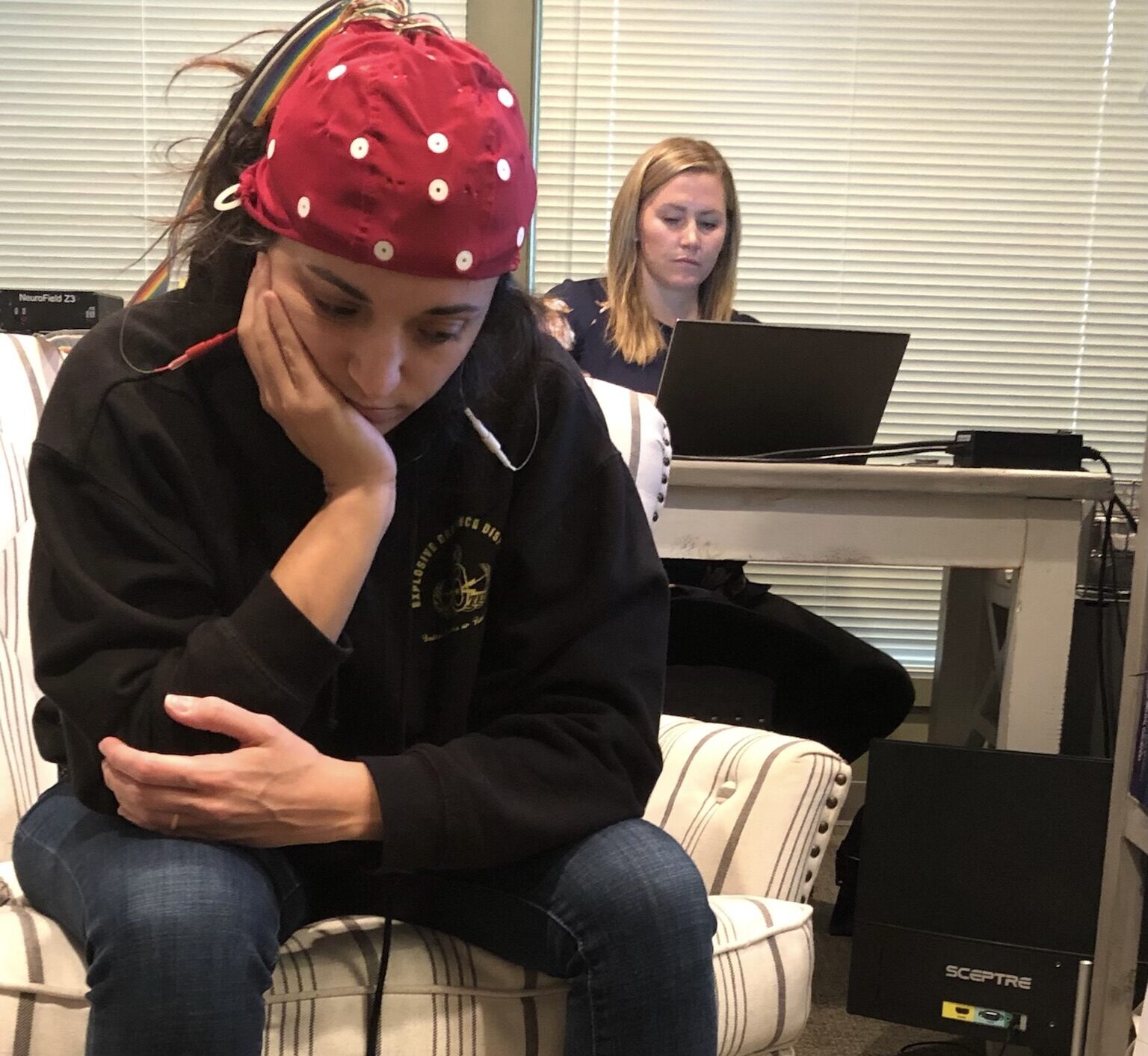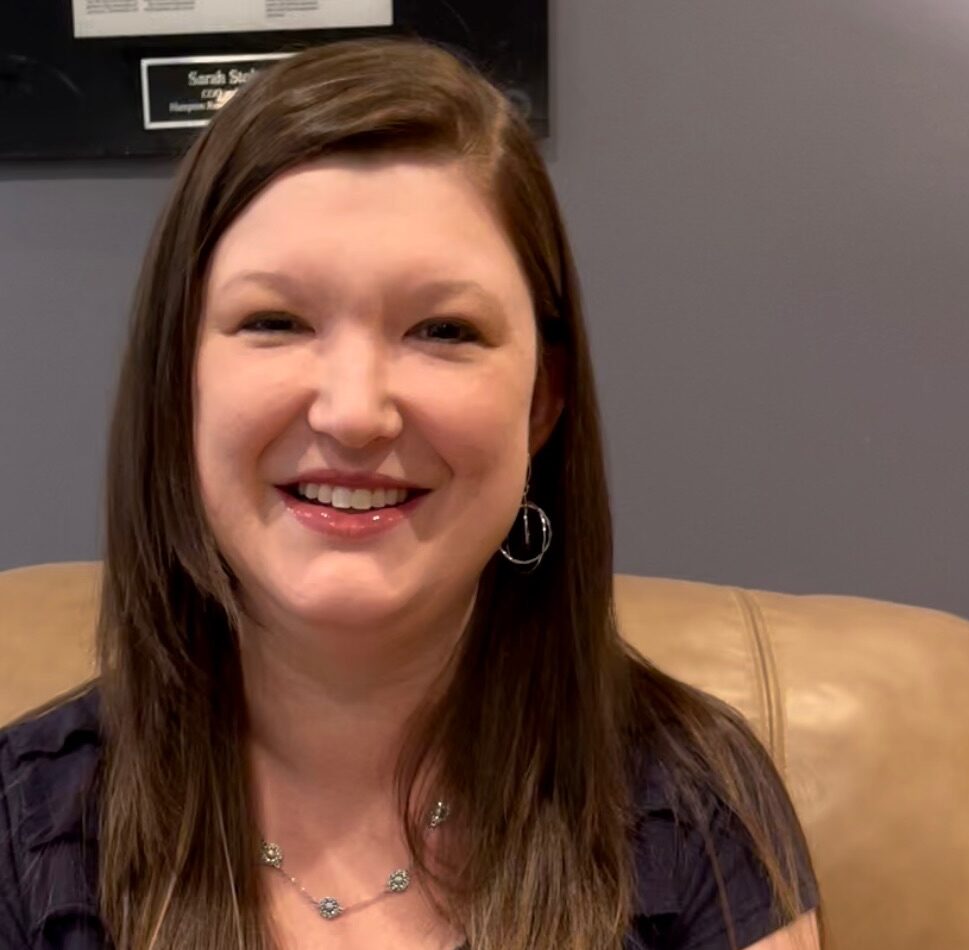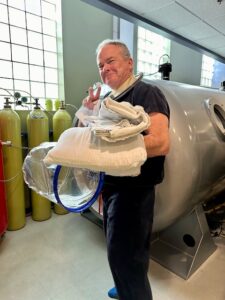 The original article was originally published in the Virginian Pilot on 9/11/12 titled, “Hampton Roads oxygen therapy gives hope to veterans suffering from service-related illnesses.”
The original article was originally published in the Virginian Pilot on 9/11/12 titled, “Hampton Roads oxygen therapy gives hope to veterans suffering from service-related illnesses.”
Scars litter the arms of retired Navy Captain John Cole. The fresher ones are pink while the lighter ones had healed over the years. Dozens more are hidden beneath his clothing from the tops of this knees up the front of his body. “I’ve had 51 carcinomas. Last 7 years I’ve averaged, in the melanoma clinic at Portsmouth Naval Hospital, four biopsies with one positive every quarter. So that’s 16 biopsies and four carcinomas a year,” Cole said. “Since I’ve done this [hyperbaric oxygen therapy], going on 26 months I have had just nine biopsies and one carcinoma. Physically, Cole said, he is a new man.
“I am back in control of my body and my mind,” Cole said.
Cole, a Virginia Beach resident, is one of hundreds of military veterans who have been treated at Tier 1 Therapy Centers, formerly Hampton Roads Hyperbaric Center in Norfolk’s Neon District. The female veteran-owned private clinic at 129 W. Virginia Beach Blvd. attracts patients from Williamsburg, Richmond, and Elizabeth City, North Carolina.
For the hyperbaric therapy, up to four people climb inside what looks like a small submarine to go “diving.” Once inside, the chamber is slowly pressurized to simulate 16-33 feet below sea level. Patients are administered 100% medical grade oxygen through a lightweight hood worn over their heads for 60-90 minutes before gradually returning to normal pressure levels.
The center also has a mono chamber designed to hold a single patient.
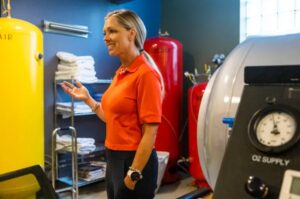 “When you have illness, injury or disease, a lot of times your cells don’t function properly. They don’t get the oxygen that they need,” said Cara Mae Melton, president of the therapy center.
“When you have illness, injury or disease, a lot of times your cells don’t function properly. They don’t get the oxygen that they need,” said Cara Mae Melton, president of the therapy center.
Holding the tip of her finger tightly, making it turn purple, Melton added, “If you cut off oxygen, even at this small little level, your finger starts to turn. If you kept that like that, eventually the cells would die. The same thing happens when you have an injury. You knock out the blood flow, and sometimes it doesn’t come back.”
The treatment forces 100% oxygen to permeate through the blood plasma, eventually creating new blood cells that carry more oxygen further into the tissue at a greater rate. This treatment encourages the body to heal itself, the clinic website says. It is considered adjunctive and should be used in conjunction with other treatment options.
Hyperbaric oxygen therapy can be used to treat myriad injuries, illnesses and diseases, Melton said, such as neuropathy, chronic pain, inflammation and stroke. But it also treats wounds that are invisible to the eye — depression, anxiety, anger, insomnia, which can all lead to suicidal ideations. The Food and Drug Administration has cleared its use for certain medical conditions, but other uses are considered off-label.
“Our niche has organically become traumatic brain injury treatment and post-traumatic stress disorder treatment for special operation forces veterans,” Melton said.
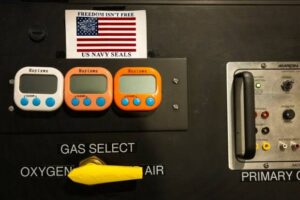 An American flag sits on the control panel for the multiperson hyperbaric chamber at Tier 1 Therapy Centers in Norfolk on Wednesday. Tier 1 has been using hyperbaric therapy to treat veterans with traumatic brain injuries and post-traumatic stress disorder. (Kendall Warner/The Virginian-Pilot)
An American flag sits on the control panel for the multiperson hyperbaric chamber at Tier 1 Therapy Centers in Norfolk on Wednesday. Tier 1 has been using hyperbaric therapy to treat veterans with traumatic brain injuries and post-traumatic stress disorder. (Kendall Warner/The Virginian-Pilot)
Tier 1 Therapy Centers originally opened under a different name in 2012. Since then, the center has treated hundreds of veterans for service-related injuries and illnesses.
“Military training in itself is detrimental on the body. Members experience concussions and minor brain injuries all the time. They are around concussive incidents, like repeated gunfire, which creates little bubbles in the brain,” said Melton, a Navy veteran who served from 1995 to 2000.
The “toxic environment” combined with the high tempo, high stress nature of training and deployment cycles, she said, can overtake the body, which is when patients will begin to experience persistent headaches, insomnia and changes in mood and behavior.
“When you have that over and over again, your body stops healing it,” Melton said.
The treatment plan is expensive, averaging $7,000 per patient, and demanding as it requires most patients to commit to coming to the center Monday through Friday for eight weeks.
There are 14 health conditions that can be treated with hyperbaric oxygen therapy for which insurance will pay. Off-label treatments for service-related traumatic brain injuries and post-traumatic stress disorder are not covered by insurance.
Cara Mae Melton, president of the company, talks about the benefits of hyperbaric therapy at Tier 1 Therapy Centers in Norfolk on Wednesday. (Kendall Warner/The Virginian-Pilot)
So, the center seeks other funding sources like donations and grants from nonprofit organizations to help pay veterans’ treatment bills, particularly with more than 700,000 veterans across Virginia and 200,000 living in Hampton Roads, Melton said.
She said nonprofits have to go out into the community and drum up awareness, interest and money “at a time when people think that everything is fine with our veterans because we are not actively at war.”
In March, Virginia lawmakers passed Senate Bill 1082, which allows the Department of Veterans Services to recommend hyperbaric oxygen therapy for veterans with traumatic brain injuries and post-traumatic stress disorder. This, Melton said, is a glimmer of hope that veterans will eventually receive insurance coverage for their invisible wounds.
Until then, Virginia Beach nonprofit Coastal Authority Care Foundation works to raise funding for veterans to receive the oxygen therapy. Jill Crist created the foundation in 2015 after her husband, a retired Navy SEAL, received the treatment in Texas.
“My husband was saying ‘I don’t want to be here anymore’,” Crist said. “Doctors were giving him medication for sleep. They were giving him medication for migraines. They were giving him medication for depression. And it was just all making him feel drugged. It was all he could do to make it through the day.”
Another retired SEAL told the Crists about hyperbaric oxygen therapy. Crist said the paperwork for a consultation sat on their kitchen counter for two months before she filled it out for her husband.
“He was being obstinate because he felt others needed it more than him,” Crist said, “but I was thinking no one needed it more than him. The spouse sees the burden they carry.”
Her husband participated in a brain stimulation therapy and followed it up with eight weeks of hyperbaric oxygen therapy in March 2015.
“He was golden, just positively golden — and his body was healing,” Crist said. “He was sleeping again, and he started working out again, training for a crazy 32-mile paddleboard race from Molokai to Oahu. He completed the race in 2018.”
Crist and her husband returned from Texas and immediately launched the nonprofit organization in an effort to raise awareness and funding for the therapy. In 2022, it donated $40,000 in grants to 11 veterans.
“I was one of those veterans,” Cole said.
An American flag sits on the the multiperson hyperbaric chamber at Tier 1 Therapy Centers, formerly known as Hampton Roads Hyperbaric Chambers, in Norfolk on Wednesday. Tier 1 has been using hyperbaric therapy to treat veterans with traumatic brain injuries and post-traumatic stress disorder. (Kendall Warner/The Virginian-Pilot)
Cole went through about six weeks — or 30 sessions — of hyperbaric oxygen therapy in February 2022 and about two weeks of “maintenance” hyperbaric oxygen therapy in the fall.
Cole said he was about halfway through the therapy when he noticed an improved mood and consistently better sleep — a departure from the sleep deprivation and mood swings he had experienced. Over the next year, he realized his body was no longer riddled with current carcinomas, healing wounds, stitches. All of which were a side effect of the intense radiation he was exposed to from the radars while flying F-14 and F-18 fighter jets for three decades.
“The military trains everybody to compartmentalize — to ignore everything that is going on around and unto themselves so they can focus on the mission,” Cole said. “So, you don’t go to the doctor when you have a problem. You try and hide the problem so you can deploy, so you can fly the airplanes, so you can do your job. And when you get out, you don’t know where to start.”
Cole said his medical battle overwhelmed his immune system and himself. On one hand I was fighting major inflammation from a broken neck incurred while flying Tomcats (Cole is fused C7-C3) and the toxicity of my skin which seemed to be a fertile ground for cancerous growth. Until like Jill’s husband, a friend, also SPECWAR told me about HBOT and his personal success story. However. It’s a multi front battle, I have a great team of folks at Portsmouth Naval Hospital who have found and removed all the carcinomas before they could get in deep and become metastatic. But nowhere could I find how to reduce the number of carcinomas growing on my body. That is until HBOT.
“You take strong people and just assume they are going to be strong for the rest of their life,” Cole said. “It is a trapdoor.”
Motioning to Melton and Crist, he added, “I owe my life to them, because that’s what they are doing — saving lives.”
Caitlyn Burchett, [email protected]
Caitlyn Burchett, [email protected]
Photos: Kendall Warner/The Virginian-Pilot
